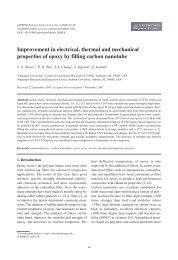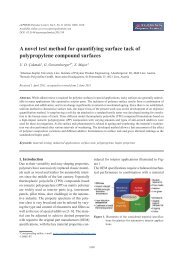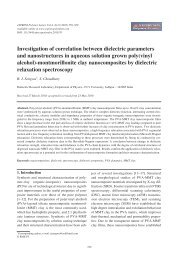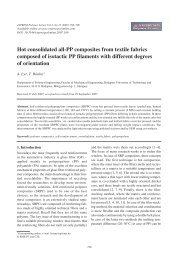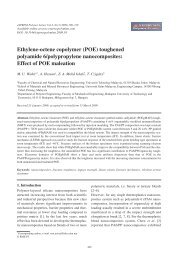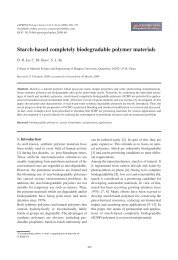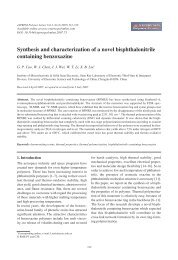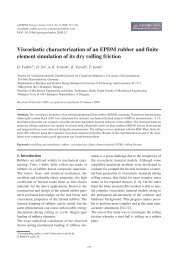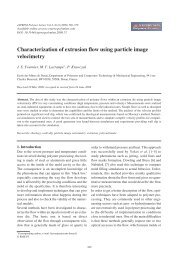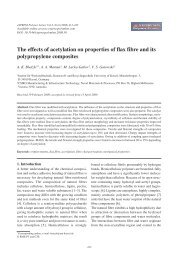Nanotechnology and its applications in lignocellulosic composites, a ...
Nanotechnology and its applications in lignocellulosic composites, a ...
Nanotechnology and its applications in lignocellulosic composites, a ...
You also want an ePaper? Increase the reach of your titles
YUMPU automatically turns print PDFs into web optimized ePapers that Google loves.
Kamel – eXPRESS Polymer Letters Vol.1, No.9 (2007) 546–575<br />
entangled nanotube network was found to have an<br />
<strong>in</strong>fluence on the composite tensile behavior only at<br />
high temperatures. Such a soft network is efficient<br />
for mechanical re<strong>in</strong>forcement when the polymer<br />
matrix is highly viscous. Opuntia ficus-<strong>in</strong>dica<br />
cladode cells were <strong>in</strong>dividualized under alkal<strong>in</strong>e<br />
conditions <strong>and</strong> homogenized under a shear action<br />
to produce cellulose microfibril suspensions. Individualized<br />
microfibrils consist of flexible <strong>and</strong><br />
hairy, high aspect ratio fibers almost 5 nm <strong>in</strong> width.<br />
The result<strong>in</strong>g suspension was used to process<br />
nanocomposite materials with a high level of dispersion<br />
us<strong>in</strong>g latex of poly (styrene-co-butyl acrylate)<br />
as a matrix. Cellulose microfibrils br<strong>in</strong>g a<br />
great re<strong>in</strong>forc<strong>in</strong>g effect at high temperature (T > T g<br />
of the matrix) <strong>and</strong> improve the thermal stability of<br />
the composite materials, even at very low filler<br />
load<strong>in</strong>g. The swell<strong>in</strong>g behavior of the polymeric<br />
matrix was found to strongly decrease even at only<br />
1 wt% of cellulose microfibrils <strong>and</strong> was almost<br />
<strong>in</strong>dependent of the filler content [60].<br />
Three types of surface characteristics cellulose<br />
whiskers were compared; aggregated whiskers<br />
without surface modification, aggregated whiskers<br />
grafted with maleated polypropylene, <strong>and</strong> novel<br />
surfactant-modified whiskers. The whiskers were<br />
<strong>in</strong>corporated as nanometric fillers <strong>in</strong>, polypropylene,<br />
by solvent cast<strong>in</strong>g from toluene followed by<br />
film press<strong>in</strong>g. The crystallization behavior of the<br />
films, as evaluated by X-ray diffraction, displayed<br />
two crystall<strong>in</strong>e forms (α <strong>and</strong> β) <strong>in</strong> the nano<strong>composites</strong><br />
conta<strong>in</strong><strong>in</strong>g aggregated whiskers without surface<br />
modification <strong>and</strong> novel surfactant-modified<br />
whiskers, whereas the neat matrix <strong>and</strong> the material<br />
re<strong>in</strong>forced with aggregated whiskers grafted with<br />
maleated polypropylene only crystallized <strong>in</strong> the<br />
α-form. Differential scann<strong>in</strong>g calorimetry experiments<br />
also <strong>in</strong>dicated that the aggregated surfactantmodified<br />
whiskers acted as nucleat<strong>in</strong>g agents for<br />
the polypropylene. The α-phase crystallites represent<br />
the predom<strong>in</strong>ant part of the neat polypropylene,<br />
whereas the appearance of the other two<br />
phases (β or γ) may eventually be favored by the<br />
presence of fillers, under high pressure or by thermal<br />
anneal<strong>in</strong>g. The mechanical properties of the<br />
nanocomposite films were evaluated by dynamic<br />
mechanical analysis, <strong>and</strong> were found to be significantly<br />
enhanced by the <strong>in</strong>corporation of the cellulose<br />
whiskers. Particularly, the materials with novel<br />
surfactant-modified whiskers <strong>and</strong> aggregated<br />
whiskers without surface modification displayed<br />
<strong>in</strong>creased moduli as compared to the neat matrix<br />
<strong>and</strong> the aggregated whiskers grafted with maleated<br />
polypropylene composite. The presence of the<br />
β-phase may have an important <strong>in</strong>fluence on the<br />
mechanical properties of the result<strong>in</strong>g <strong>composites</strong>,<br />
s<strong>in</strong>ce <strong>its</strong> toughness is higher than that of the<br />
α-phase [61]. An environmental friendly chemical<br />
modification route to confer high hydrophobicity to<br />
crystall<strong>in</strong>e cellulose was developed. With low<br />
reagent consumption <strong>and</strong> simple treatment procedures,<br />
highly hydrophobic whiskers can be obta<strong>in</strong>ed.<br />
The acylated whiskers, us<strong>in</strong>g iso-octadecenyl succnic<br />
anhydride <strong>and</strong> n-tetradecenyl succ<strong>in</strong>ic anhydride<br />
as acylat<strong>in</strong>g agent, could disperse <strong>in</strong> mediumto<br />
low-polarity solvents, i. e., dimethyl sulfoxide to<br />
1,4-dioxane. By controll<strong>in</strong>g the heat<strong>in</strong>g time,<br />
whiskers with different dispersibility could be<br />
obta<strong>in</strong>ed. Based on <strong>its</strong> organic-solvent dispersibility,<br />
the acylated whiskers are expected to be useful<br />
<strong>in</strong> direct mix<strong>in</strong>g with synthetic res<strong>in</strong>s to form<br />
nano<strong>composites</strong> with improved dispersion <strong>and</strong><br />
adhesion with matrices [55].<br />
1.2.3. Bacterial cellulose<br />
Besides be<strong>in</strong>g the cell-wall component of plants,<br />
cellulose is also secreted extracellularly as synthesized<br />
cellulose fibers by some bacterial species.<br />
Bacterial cellulose is produced by Acetobacter<br />
species cultivated <strong>in</strong> a culture medium conta<strong>in</strong><strong>in</strong>g<br />
carbon <strong>and</strong> nitrogen sources. It presents unique<br />
properties such as high mechanical strength <strong>and</strong> an<br />
extremely f<strong>in</strong>e <strong>and</strong> pure fiber network structure.<br />
This network structure is <strong>in</strong> the form of a pellicle<br />
made up of a r<strong>and</strong>om assembly of ribbon shaped<br />
fibrils, less than 100 nm wide, which are composed<br />
of a bundle of much f<strong>in</strong>er microfibrils, 2 to 4 nm <strong>in</strong><br />
diameter. Bacterial cellulose microfibrils have a<br />
density of 1600 kg/m –3 [62–65]. In addition, it has<br />
sufficient porosity, 3-dimensional (3-D) network<br />
structure, water hold<strong>in</strong>g capability, <strong>and</strong> biocompatibility<br />
[66].<br />
Instead of be<strong>in</strong>g obta<strong>in</strong>ed by fibrillation of fibers,<br />
bacterial cellulose is produced by bacteria <strong>in</strong> a<br />
reverse way, synthesiz<strong>in</strong>g cellulose <strong>and</strong> build<strong>in</strong>g up<br />
bundles of microfibrils. These bundles are somewhat<br />
straight, cont<strong>in</strong>uous, <strong>and</strong> dimensionally uniform.<br />
In addition, compared with animal-derived<br />
polymers, bacterial cellulose is free of any occurrence<br />
of cross <strong>in</strong>fection likely associated with collagen.<br />
Current <strong>applications</strong> for bacterial cellulose<br />
551




